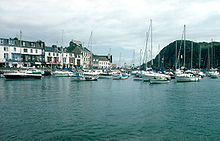Ilfracombe
![]()
This article describes the small English town. For the town of the same name in the South African province of KwaZulu-Natal, see Ilfracombe (South Africa); for the town of the same name in Queensland, Australia, see Ilfracombe (Queensland).
51.2066666667-4.12944444444Coordinates: 51° 12′ N, 4° 8′ W
Ilfracombe is a small town with a population of 12,510 (2006) on the north coast of the south-west English county of Devon. It has a small natural harbour dominated by the town's natural landmark, Hillsborough Hill, with the remains of an Iron Age Celtic fortification.
The manor of Chambercombe, in the eastern part of the town, dates back to the Norman knight Champernon (from Chambernon in France) who came to England with William the Conqueror. The building is first mentioned in 1086.
Ilfracombe consisted of two distinct communities: around the parish church the farmers had settled, and at the harbour the fishermen. The land at the church belonged to the Champernowne family, that at the harbour to the Bouchiers, Earls of Bath. The harbour achieved early importance on the Bristol Channel. In 1208, for example, the parish provided King John I with a ship for his campaign of conquest to Ireland, and in 1247 it provided a ship for the conquest of the Western Isles of Scotland. Ships were also sent from Ilfracombe for the siege of Calais, and two strong military formations were stationed here to suppress the Irish. The lighthouse, which stands at the harbour on Lantern Hill, has been in operation for over 650 years, making it the longest serving in the UK.
Until the mid-19th century, fishing and maritime trade were the main sources of income in Ilfracombe. In Victorian times, the town gradually developed into a holiday resort due to the increase in ferry services along the Bristol Channel. The redevelopment progressed even more rapidly when an efficient railway network was established. However, further changes on a large scale were hindered by the town's awkward location in the hills, sandwiched between the cliffs and the sea. As a result, the townscape still displays a distinctly Victorian character today. Many of the large, elegant houses have become comfortable hotels.
The town has spread out around the old harbour. Today, fishing boats share the anchorage with pleasure boats and the Oldenburg, which regularly sails to the island of Lundy, 19 km away. There are also boat services to Porthcawl near Swansea in Wales. The port of Ilfracombe made spectacular headlines in the world press in 2012 after the British artist Damien Hirst had his 25-metre-high bronze statue Verity erected there.

Ilfracombe High street

The Port of Ilfracombe
Twin Cities
- Herxheim
Sons and daughters of the city
- Ruth Downie (* 1955), English writer
- Vic Gentils (1919-1997), Belgian sculptor
Search within the encyclopedia